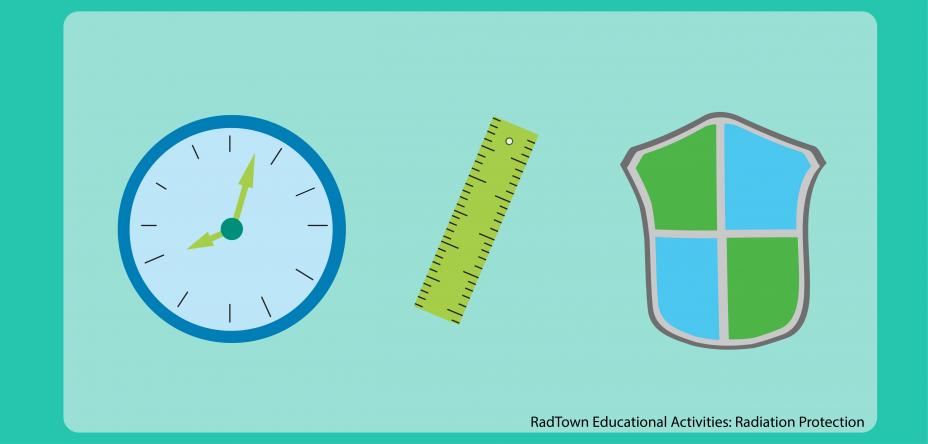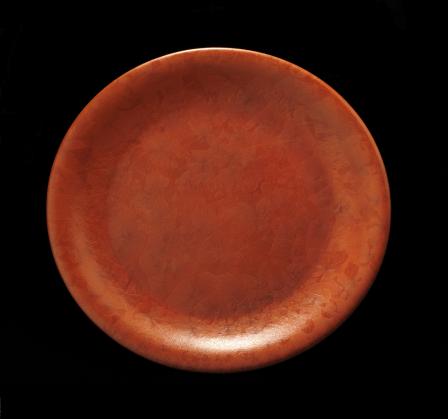The three principles of radiation protection are time, distance and shielding. To minimize your exposure to ionizing radiation, limit the amount of time you spend near a radioactive source, increase the distance between you and a radioactive source, and put a barrier, like a concrete wall, between you and a radioactive source. People who work with radiation use these three principles every day to stay safe in their work. This activity is intended for middle and high school students.
- Objectives
- Next Generation Science Standards
- Materials and Resources
- Time
- Directions
- Common Core State Standards
- Printable Worksheets and Classroom Aids
Objectives
Students will:
- Investigate how time, distance and shielding can reduce exposure risks.
Next Generation Science Standards
The concepts in this activity can be used to support the following science standards:
- PS4. Waves and Electromagnetic Radiation
Materials and Resources
Each italicized document title can be found at the bottom of this page, and is available for printing and distribution.
- Radiation Protection: Teacher Background Information
- Vocabulary Materials
- Radiation Protection Worksheet (one per student, pair or group)
- Applying Time, Distance and Shielding Worksheet (one per student, pair or group)
- Option A (per group or class based on supplies available)
- Geiger counter and radioactive source (e.g., commercially purchased source, Fiesta dinnerware, luminescent clock or watch face, or gas camping lantern with a thorium mantel)
- Alternative to Geiger counter: Heat source (e.g., hot plate or heat lamp)
- Measuring device (ruler, measuring stick or tape measure)
- Clock with a second hand or a stopwatch
- A thermometer (if using a heat source)
- Shielding sources (e.g., piece of glass, clothing or aluminum foil; or sheet of paper or metal)
- Option B and C:
- Student computers with Internet access or printed resources for students with information about protection measures taken in nuclear reactor incident(s)
Time
45-60 minutes, depending on the activity option chosen. Students may also complete the activity outside of class and discuss their findings in the next class period.
Vocabulary
- Geiger counter
- Ionizing radiation
- Radiation
- Radiation exposure
- Radiation protection
Directions
- Start with a vocabulary activity if students are not familiar with radiation and the terms used in this activity, or provide students with the terms and definitions.
- Explain that there are situations in which we may or may not have control over our exposure to ionizing radiation. Ask students:
- When do we not have control over our exposure to radiation? We do not have control over our exposure to some naturally occurring (background) radiation, and we may not have control over our exposure to undetected sources of radiation.
- When do we have control over our exposure to radiation? Examples may include when evaluating whether to have an x-ray or medical procedure (using radiation), when testing for and fixing radon levels in your home, or when following warnings or emergency response directives and staying away from radioactive areas.
- Why might we want to limit our exposure to radiation when possible? Radiation can deposit energy in body tissue and can damage or kill cells.
- Select and prepare an activity option:
- Option A: Have students use a Geiger counter and a radioactive source or heat source and thermometer to conduct an experiment and test possible radiation protection methods. Provide time, distance and shielding materials that are listed in Materials and Resources.
- Option B: Have students predict what steps they can or might take to reduce their exposure to radiation (e.g., if living near a radioactive area like an abandoned uranium mine, if finding an orphan radioactive source, or in the event of a nuclear explosion or accident).
- Option C: Have students research what radiation protection concepts are, and have been, used in radiological emergencies (e.g., Japan’s Fukushima nuclear power plant incident or other historical nuclear power plant incidents).
- Option D: Have students interview a person who practices radiation protection at work to determine what radiation practices are followed according to the source(s) of radiation used. Interviewees may include medical, dental or veterinary staff; x-ray equipment or environmental inspectors; people who test and resolve radon issues; Department of Health staff who deal with radiation issues; truck drivers who haul radioactive materials; emergency responders; researchers; power plant workers; radon mitigation workers; and construction workers who use moisture and density nuclear gauges.
- Explain to students that their task is to hypothesize and test (or research) ways people can limit their exposure to ionizing radiation.
- Introduce the three main concepts of radiation protection. Determine how much information you want to provide about these concepts before students complete the activity and investigate the concepts. For instance if using Option A, you may want students to identify these concepts through the activity and review the concepts afterwards. Information on the concepts (time, distance and shielding) can be found in the Radiation Protection: Teacher Background Information.
- Distribute the Radiation Protection Worksheet (if using Option A) or the Time, Distance and Shielding Worksheet (if using Options B through D). Have students work in pairs or small groups to conduct the activity and complete the worksheet. Students should determine that one can limit their exposure by:
- Limiting their time spent near a radiation source.
- Increasing the distance from a radiation source.
- Using shielding to provide a barrier between themselves and a radiation source.
- Have students share the radiation protection concepts they identified in their experiment or research and how they help reduce or eliminate a person’s exposure to radiation. Prompt students to consider how using two or more forms of protection might affect a person’s exposure level. NOTE: You may want to extend Activity Option A and have students hypothesize and test how using two or more forms of protection might affect a person’s exposure level if they did not already do so.
- Since answers will vary based on the activity chosen for the classroom, no teacher key is provided. Please see Radiation Protection: Teacher Background Information for additional information about concepts and radiation protection principles.
Common Core State Standards (CCSS)
The concepts in the Time, Distance and Shielding activity align with the following:
CCSS English Language Arts Standards for Literacy in History/Social Studies, Science, & Technical Subjects:
- CCSS.ELA-LITERACY.SL.6-12.1 Comprehension and Collaboration
- CCSS.ELA-LITERACY.WHST.6-12.2 Text Types and Purposes
- CCSS.ELA-LITERACY.WHST.6-12.9 Research to Build and Present Knowledge
CCSS Mathematics Standards:
- CCSS.MATH.PRACTICE.MP1
- CCSS.MATH.PRACTICE.MP2
- CCSS.MATH.PRACTICE.MP5
- CCSS.MATH.CONTENT.6.SP.B.5
- CCSS.MATH.CONTENT.6.SP.B.5.B
- CCSS.MATH.CONTENT.7.EE.B.4
- CCSS.MATH.CONTENT.HSN.Q.A.1
Printable Worksheets and Classroom Aids
You may need a PDF reader to view some of the files on this page. See EPA’s About PDF page to learn more.- Radiation Protection Worksheet (PDF)(1 pg, 85 K)
- Applying Time, Distance and Shielding Worksheet (PDF)(1 pg, 110 K)


